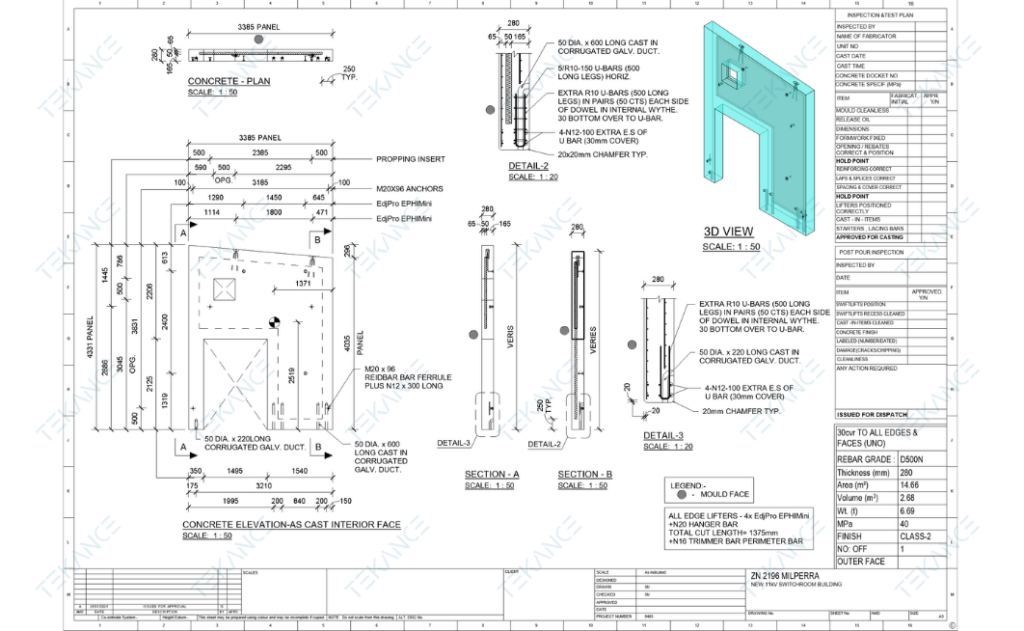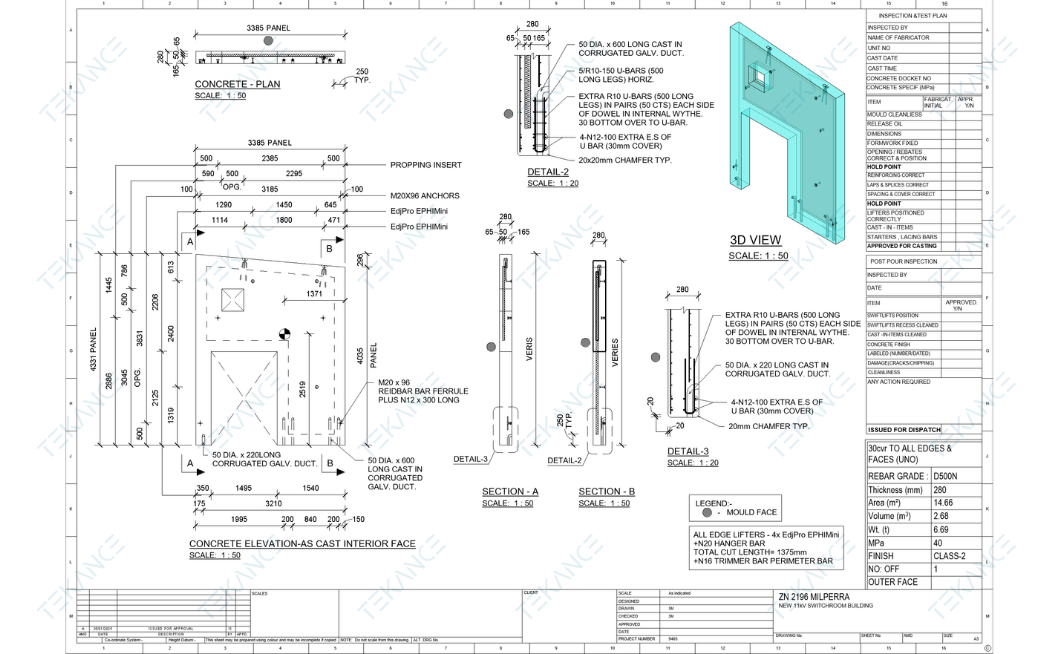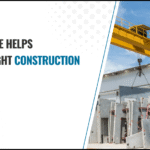Precast detailing is the process of designing and detailing precast concrete elements before they are manufactured. It’s the process of creating detailed drawings and models before concrete elements are made in a factory and transported to a construction site.
Why does this matter? Because getting every measurement, connection, and detail right ensures that everything fits perfectly when assembled on-site. No last-minute surprises, no costly errors!
In this guide, we’ll walk you through what precast detailing is, why it’s important, the tools used, and how it’s shaping modern construction.
Let’s get started!
Key Takeaways
- Precast detailing helps ensure accuracy, efficiency, and quality in precast concrete construction.
- It reduces material waste and speeds up the construction process.
- Software like Tekla, AutoCAD, and Revit are widely used for precast detailing.
- Precast concrete is commonly used in commercial, residential, and infrastructure projects.
- Following industry standards is crucial for safety and compliance.
What is Precast Detailing?

Precast detailing is the process of designing and detailing precast concrete elements before they are manufactured. This includes creating precise shop drawings, reinforcement details, and connection plans.
Think of it like Lego blocks—each piece must be designed perfectly so that when it’s put together, the final structure is strong and stable.
Without proper detailing, there could be errors in dimensions, misaligned connections, or even safety risks.
Why is Precast Detailing Important in Construction?
1. Saves Time and Money
Precast elements are manufactured in a controlled factory setting, meaning they are made faster and with better quality control than on-site concrete pouring.
2. Reduces Waste
Since everything is planned in advance, there’s less material wastage, making it an eco-friendly construction method.
3. Improves Safety
Factory-made precast elements are stronger and have fewer defects, making them safer than traditional on-site concrete construction.
4. Ensures Structural Integrity
Good detailing means every element fits together perfectly, ensuring a sturdy and durable building.
Where is Precast Concrete Used?
Precast concrete is everywhere, even if you don’t realize it!
✔ Commercial Buildings – Office buildings, shopping malls, and warehouses.
✔ Residential Projects – Apartments, villas, and housing complexes.
✔ Infrastructure – Bridges, tunnels, metro stations.
✔ Industrial Structures – Factories, storage units, and parking structures.
Because precast concrete is strong, durable, and cost-effective, it is used in both small and large-scale projects around the world.
What Are the Key Elements in Precast Concrete?
- Precast Slabs – Used for floors and ceilings. Can be hollow-core, solid, or double-tee slabs.
- Precast Columns and Beams – Provide structural support to buildings.
- Precast Walls – Can be load-bearing or non-load-bearing.
- Precast Stairs and Landings – Used for staircases in buildings.
Each element is precast, transported, and assembled at the construction site like a giant puzzle.
Precast Concrete vs. Traditional Cast-in-Place Concrete
| Feature | Precast Concrete | Cast-in-Place Concrete |
|---|---|---|
| Speed | Faster production & installation | Takes longer due to on-site pouring |
| Quality Control | Made in a factory under strict conditions | Prone to weather & human errors |
| Cost Efficiency | Reduces waste & labor costs | Can be expensive due to on-site work |
| Durability | Stronger due to controlled curing | May have inconsistencies |
Upcoming trends in precast concrete detailing are expected to further enhance efficiency and precision.
How is Precast Detailing Done? (Step-by-Step Process)
1. Understanding Project Requirements
Engineers and architects discuss what needs to be built and the specifications.
2. Creating 3D Models
Using BIM (Building Information Modeling) software, engineers create 3D models of each element.
This helps visualize how everything fits together.
3. Generating Shop Drawings
Detailed drawings are made for manufacturing each element in the factory.
4. Adding Reinforcement Details
Steel reinforcements are added to ensure structural strength.
5. Reviewing & Approving Designs
Everything is double-checked before production begins to avoid costly mistakes.
What Software is Used for Precast Detailing?
- Tekla Structures – Popular for BIM-based detailing.
- AutoCAD – Used for 2D & 3D precast drawings.
- Revit – Advanced 3D modeling for precast elements.
- StruCAD, Allplan Precast, BricsCAD – Other software used in detailing.
Each software helps create accurate models, detect clashes, and ensure perfect assembly.
Challenges in Precast Detailing & How to Solve Them
Dimensional Accuracy Issues
Solution: Use 3D modeling software to detect errors early.
Connection Complexity
Solution: Standardize joint designs for easier assembly.
Transportation & Handling Problems
Solution: Optimize precast element sizes for easy transport.
To maintain high standards, detailed precast detailing quality evaluations are essential.
Future Trends in Precast Detailing
✅ Automation & AI – AI-driven detailing for error-free designs.
✅ 3D Printing – Printing precast elements for faster production.
✅ Sustainability – Using eco-friendly materials in precast.
✅ Digital Twins – Real-time monitoring of precast structures.
The future of precast detailing is digital and automated!
Explore more about the latest 2025 trends in precast concrete detailing and how they’re shaping the industry.
Final Thoughts
Precast detailing is a game-changer in modern construction. It helps builders save time, reduce costs, and improve quality. With the right tools, standards, and technology, precast concrete is set to revolutionize the industry even more.
For professional assistance, explore our precast detailing services to ensure precision and quality in every project.








